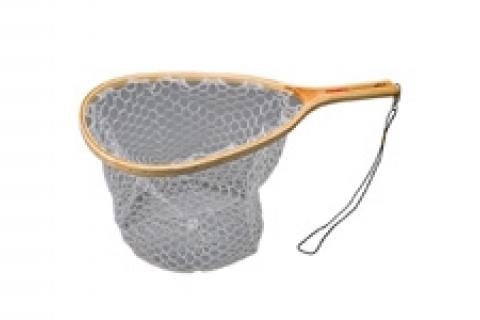
 When discussing the best means of handling a freshly-landed trout, which will then be released, opinions vary as whether or not to net the fish.
When discussing the best means of handling a freshly-landed trout, which will then be released, opinions vary as whether or not to net the fish.
In the case of medium- to larger-sized trout, a strong argument can be made for netting. While it's practical to cradle a smaller fish and then reach down with forceps and twist free a fly, lure or hook, the same can't be said for fish exceeding the foot-long mark.
Handling a larger fish without netting it generally comes down to three options. One, you can play the fish until it's fatigued to the point that it behaves well at boot-side. But exhausted fish are frequently dead fish, particularly in summer's warmer water. So this isn't a good choice. Secondly, if you bring the fish in "green," chances are excellent you'll leave a fly (or lure or hook) in its mouth as it breaks off while you're attempting to grab the hook with forceps. Attempts to cradle the fish to control it — you can't lip 'em like a bass — often translate into a squirming fish with lots of protective slime removed. Lastly, you beach it on shore, but now you have a thumping fish beating itself up, in an environment where it can't breathe; not a particularly pretty alternative.
Many of these negative aspects are eliminated, or at least controlled, with a quality net, one designed with the fish's best interests in mind. This year I've used such a net: Frabill's Wooden Trout Net. It's large enough to handle any of the stream-dwelling trout in the western and central Pennsylvania freestone and limestone waters I fish. The net's bag is made of soft rubber, which is easy on the fish's fins and slime coating. The mesh is also clear, making it less visible (and likely less "spooky") to a fish about to be netted. Having a net means you can lean on the fish and land it while it still has plenty of spunk. The fish can remain submerged in the water while you unhook it. And it can remain there until it's regained its strength, minimizing contact with human hands.
Not only does this net work well, it looks great. The laminated wood teardrop-shaped frame is classic. Many trout anglers are traditionalists; this net has great aesthetic appeal.
The net's elastic lanyard comes with a quality snap. I prefer to stow the lanyard, and secure the net to the D-ring on the back of my vest with a magnetic release.
Trout are a precious commodity. Many of our high quality waters are managed on a no-kill basis. Ensuring the survival of released trout is a worthy investment in our fishing future.
- 3010 views

